by Sam Tackeff | Dec 30, 2009 | Farmers Market, Vegetables
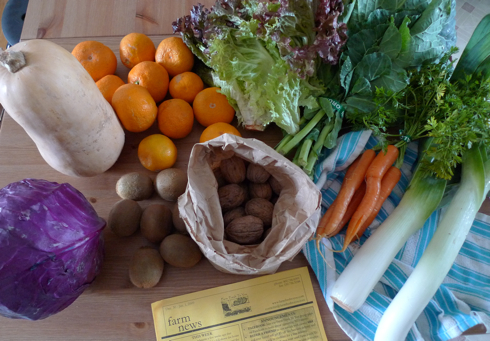
Here are the contents of this week’s farm box from Farm Fresh to You: leeks, nantes carrots, collard greens, red leaf lettuce, a red cabbage, a butternut squash, kiwifruit, and a bag of fresh walnuts. The walnuts are particularly exciting because fresh walnuts are eons better than the old, dried out stuff you get in the tins. [Yes, eons is the wrong measurement here, but I like the word, and am going to attribute using it to the mental melting that occurred last night while watching Megashark vs. Giant Octopus.]
My first step this week was to take everything out of the box and put it on the table – not specifically for a little photo shoot, but to clean and prep everything for the refrigerator. A few years at Stearns Farm and I got it down to a system: I now have Ziplocks of two sizes to keep things fresh. I rinse and dry salads, I trim off tops and excess before putting them in the refrigerator. Ok, but the photo shoot helps – specifically so that by the end of the week I don’t forget that I have something in the recess of my fridge and let it go to waste.
And then the excess tops (only leek and carrot tops this week) go in a pot with a bunch of water to make some homemade vegetable stock. Nothing to waste!
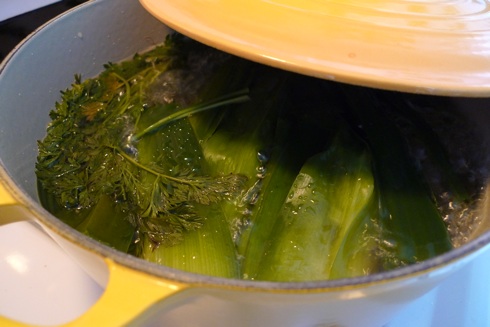
Except it’s not a perfect system. I was freezing and had the heat on yesterday and therefore couldn’t hear the gentle ho hum of the boiling pot, and consequently forgot about it until I had only a few cups of concentrated stock left.
So? Leek soup for lunch! I snipped in some fresh parsley and a good squeeze of lemon and it was ready to go.
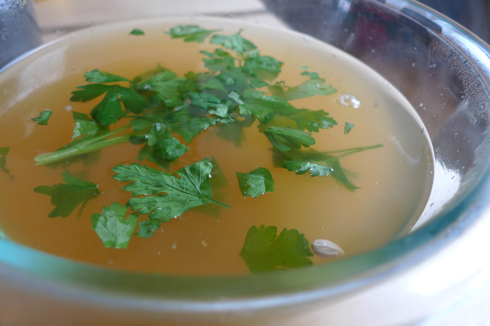
Things I plan on making this week with my vegetables:
1. Roasted Butternut Squash
2. More Kiwifruit Sorbet (notes about this soon)
3. Red cabbage and onions with Chicken Schnitzel
4. Indian Spiced Collards with Yogurt
I’m still not sure about the walnuts… I was tempted to make a walnut liquor but they are so tasty I don’t know if I want to give up the pleasure of eating them all now.
Better Ideas?
by Sam Tackeff | Dec 21, 2009 | Farmers Market, Vegetables
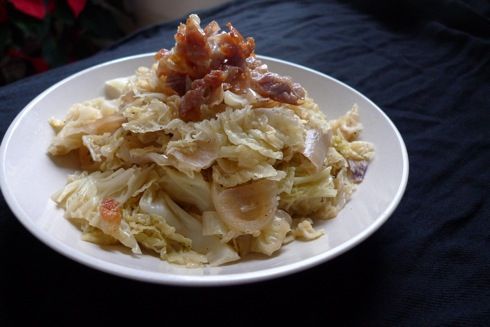
I recently subscribed to a new CSA (community supported agriculture) here in San Francisco. Every other week, I’ll be getting a box from Farm Fresh to You delivered right to my doorstep. I’ve been going each week to farmers market for the past year, but it’s a little chilly lately and I’ve been slacking. This way I’ll definitely have some fresh organic fruits and veg, even when I don’t feel like going to market. And it’ll make me eat more dark leafy greens. Kale chips, here I come.
It’s not as wondrous as my previous membership to Stearns Farm at the outer edges of Framingham, Massachusetts – but it’s still pretty exciting. [I could wax poetic about Stearns for hours – it’s exactly what a CSA should be – required farm hours, picking about half of your own weekly vegetables, shared meals, harvests, a real connection to a farm and a community, but alas, I’m a little far for that nowadays.]
This weeks box:
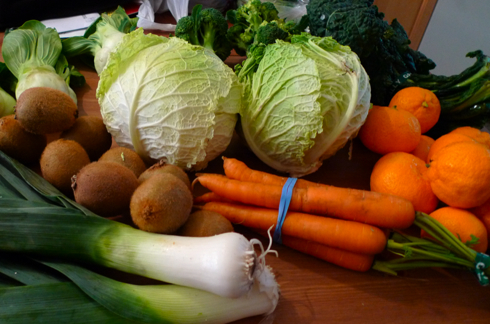
Sauteed Cabbage with Onion and Prosciutto
serves 1 as a meal, or a few as a side dish
In a heavy bottomed pot, heat a Tablespoon of Olive Oil on medium heat, and saute 4 slices (about 2 ounces) prosciutto that you have chopped until crisp, just a few minutes. Take the prosciutto out and set aside. Then, add a roughly chopped onion to the pot, and cook until slightly tender – about five minutes. Go ahead and deglaze the pan with a few tablespoons of sherry to help lift up any brown bits and add some flavor. Add in one chopped head of cabbage, preferably Savoy, but whatever you have is fine. Stir around until things are coated, add a cup of low sodium chicken stock or water, turn the heat to medium low, cover, and let braise for 20-30 minutes until everything is tender and soft. Season with lots of pepper and a tiny bit of salt. Serve hot, topped with the crispy prosciutto.
by Sam Tackeff | Oct 1, 2009 | Farmers Market, Gardening, Vegetables

While we were growing up, my dear friend Julia hated tomatoes. This was always completely perplexing to me, as there is nothing in my mind as perfect or as wonderful as a tomato. Who could possibly hate such a thing? Sweet, just slightly tangy, with multiple textures as you bite through a fresh one. And don’t get me started about sun warmed tomatoes fresh off the vine. My mother always kept them in her garden, and I remember fondly summer afternoons at my CSA picking them off the vine and eating them almost as fast as I picked them.
It’s with great sadness that I can’t grow my own tomatoes here on the third floor. Julia, at least, has since found pleasure in tomatoes, so at least I don’t have to worry about that.
Over the past few months I’ve been eating tomatoes almost every day, taking full advantage of these summer beauties before the season is completely over, and we are forced once again to give them up for the winter. Before the summer ends, I implore you to head out and try my newest tomato obsession – Dry Farmed Early Girl tomatoes.
Now, the Early Girl tomato is… gasp! a hybrid tomato!
While I do believe that choosing an heirloom vegetable over hybridized versions is important for continuing on longlasting varietals, I don’t exclude choosing hybrid tomatoes that are sustainably farmed. Early girl tomatoes are just too good to pass up, and are perfectly suited for dry farming – a technique that requires less water for farming. After transplanting, the tomato is no longer watered, which causes the roots to grow larger to attract more moisture, and in consequence, the tomato ends up with a more concentrated tomato-ey flavor. In this neck of the woods, Dirty Girl Produce happens to be championing the dry farming of early girls, and I’m so happy to support them.
After reading about these for weeks – and finally picked up some of my own at farmers market. Oh my goodness. How have I lived without them? These beauties I picked up from Dirty Girl Produce – I’ve been getting them at the farmers market, and when I needed a midweek fix I was so excited to see them at the new Whole Foods in my neighborhood.
I think I’m also smitten because Joe Schirmer, who owns Dirty Girl, is on this years reader’s choice “Farmers Under 40”, alongside Novella Carpenter, author of Farm City: The Education of an Urban Farmer. Novella made us all giggle incessantly when she came to visit Omnivore Books for a signing last month. I’m a big fan!
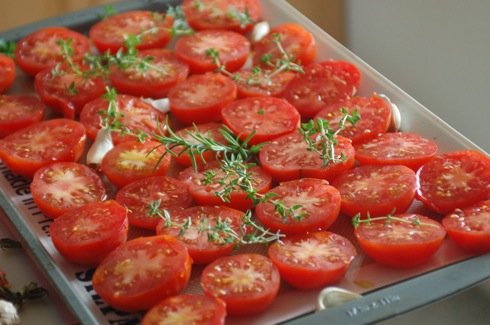
Just a few things I’ve been doing with these tasty tomatoes:
:: Sliced up for breakfast with a cube of cheddar, some turkey bacon and Turkish tea.
:: Oven- Roasted – with some olive oil and rosemary and thyme (see above). I don’t have an after photo, because, ahem, I forgot and then ate them all. I’m going to do another few batches soon and preserve some in olive oil, and puree some for the freezer.
:: “Just tomato” soup: Blended raw with basil and a little bit of chicken broth, and heated up over the stove, seasoned with salt and pepper and a swirl of peppery olive oil.
:: The Lazy Salad – Sliced up tomatoes, tossed with frisee and Whole Foods marinated gigante beans from the antipasto section.
by Sam Tackeff | Aug 9, 2009 | Farmers Market, Local stores, Shopping, Vegetables
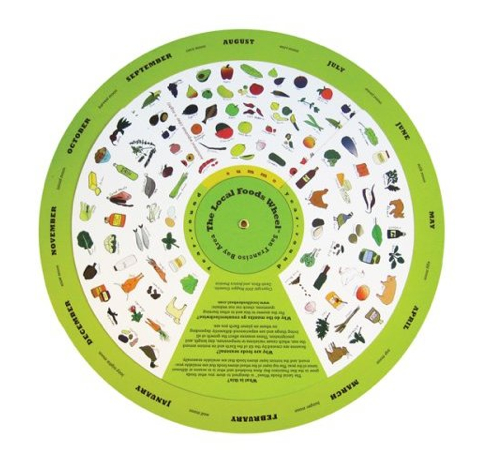
It’s something terrible we have all experienced. Accidentally eating a light pink, mealy, and flavorless tomato. Or perhaps eating a bland, completely tasteless melon. Or worse eating slices from an unripe slightly green banana. How do you ensure that you are eating the tastiest and most nutrient rich fruits and vegetables? Start eating seasonally and locally!
Eating seasonally means eating whats ripe when it reaches its natural point of the seasonal growing cycle. Heading to your local farmer’s market or green market is a good way to start, a level up would be joining a local farm’s CSA to get yourself fresh fruits and vegetables ever week or two through the summer, and even in winter. Here are my favorite go to resources:
For the Fridge: Because I live in San Francisco, I’m blessed to be able to use the Local Foods Wheel which shows both foods that are in season all year round on the inner circle, and foods coming into season on the outer circle. So far there is a New York version and a San Francisco version – let’s hope they expand soon! (If you are in SF – you can pick up your own copy at Omnivore Books! We have ’em in stock)
Portable for the tech crowd: the Seasons iPhone application will give you seasons information for “fruits, vegetables, lettuces, herbs, fungi and nuts,” for wherever you happen to be. You can view local seasons versus import seasons and see a graph that shows how “in season” a given food is. It’s $1.99, but you can take it everywhere!
There are also a few websites that are great resources: the Northeast Regional Food Guide for the New England area, and in Europe, BBC Food runs the What’s In Season page . A little more obscurely, a Swiss couple runs a site called Laughing Lemon, that also shows what is in season each month, and points out some rarer vegetables and fruits. Because the northern hemisphere has similar growing zones, these sites can be helpful for anyone in that general region. (via Maki)
For further reading, there are several cookbooks that discuss eating seasonally that I love:
– Jamie Oliver’s Jamie at Home (discusses growing and cooking methods for seasonal veg)
– Nigel Slater’s Kitchen Diaries (his eating journal for a year of dinners)
– River Cottage Vegetable Handbook – the River Cottage makes the best little handbooks on the planet. They have ones for mushrooms, preserving, bread making, and seafood as well.
Do you go to your local farmers market? Are you a member of a CSA? (Actually, if you are a member of a CSA that you love in San Francisco, gush about it here in the comments. I need suggestions! )
by Sam Tackeff | Jul 5, 2009 | Farmers Market, Salads, Vegetables
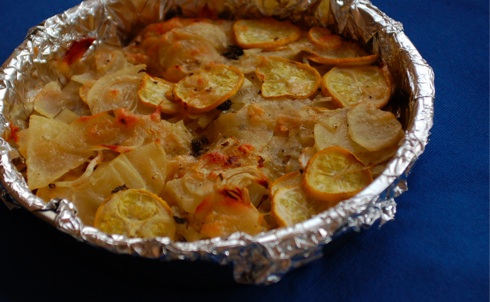
Summer squash is upon us at farmers market! And it’s cheap cheap cheap! I’ve been getting it for a dollar a pound or less, and using it baked, in salads raw, in soup, or just sliced thinly and sauteed with a little bit of olive oil, lemon juice, thyme, salt and pepper.
Today I decided that I’d go for it baked with potatoes and cheese in a little gratin – enough substance for a main meal, served with a little fresh salad of tomatoes, roasted peppers, and fresh herbs. I’ve been trying to make a good amount of my meals vegetarian, and this combo was both tasty and quite satisfying, even for the omnivores.
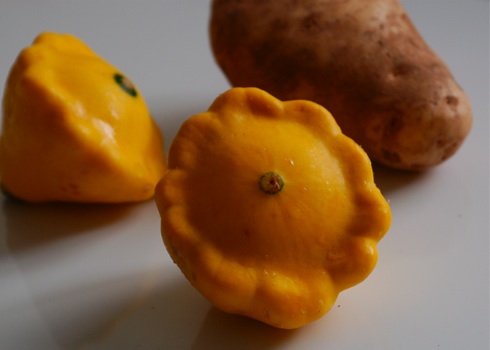
The trick to this gratin is slicing the potatoes and squash really thinly, so they cook up speedily and the whole dish is cooked through. And for the tomato salad, you want to use really ripe tomatoes, preferably heirloom tomatoes, that haven’t been refrigerated, otherwise you won’t have the burst of flavor that is so delicious in this salad.
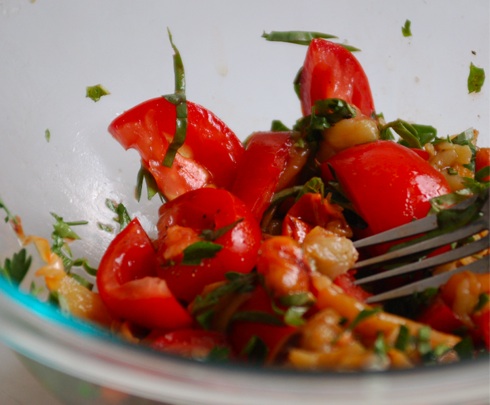
Summer Squash and Potato Gratin – serves two as a main course
:: Preheat oven to 375 degrees. On a mandolin or with a peeler, very thinly slice a pattypan squash, a summer squash (or zucchini), and a russet potato into a medium bowl. You want to make sure your potato is paper thin, or else it won’t cook all the way through. Thinly slice a shallot, and add it to the mix. Coat mixture with several good glugs of tasty olive oil, add in a few sprigs of fresh thyme, a good pinch of Maldon or other coarse salt, some fresh black pepper, and a half a cup (or more) of freshly grated Parmesan cheese. Toss well, and somewhat evenly layer into an 8-inch cake pan, lined with foil, cover with another layer of foil, and bake for about 40 minutes. Take the foil cover off, and bake an additional 15-20 minutes until top is slightly browned and crispy.
Summer Herb and Tomato Salad
:: In a bowl, slice a few really good heirloom tomatoes, about a cup of roasted red peppers, and a good handful of chopped basil, parsley, and mint. Dress with a simple balsamic vinaigrette – one part balsamic to about three parts olive oil, and a dash of salt and pepper. You can add some green lettuce, optionally. If you don’t have roasted peppers – make some – preheat the oven to 400, and pop the peppers onto a foil lined baking sheet, turning every 10 minutes or so until they have charred slightly on the outside. Let ’em sit for ten minutes or so until they are cool enough to peel, then peel, and remove the inner seeds and the stem. If you still don’t have peppers – just add a few more tomatoes, and maybe a few cubes of fresh bread if you want. Almost like panzanella. That’s about it.
by Sam Tackeff | Jun 28, 2009 | Vegetables

I love broccoli, but I know that a lot of people don’t – mostly, I’m guessing, because their experiences with broccoli were with limp, overcooked, way too pungent, and completely devoid of seasoning versions of it. This is boring and depressing, and should be avoided at all costs. Instead, try these:
The easiest way to prepare broccoli is to cut it up into florets, and thinly slice the stalk (I never throw it out!), put it all in a pyrex bowl with about an inch of water, cover it with a microwave cover or some saran wrap, and steam it for five minutes in the microwave, and drain. (Or you can steam on the stovetop – same amount of water, and a couple of minutes more – just one more pot to wash). Then you can use any of these delicious preparations to jazz up the stuff.
1. The Classic: salt, pepper, and a couple of squeezes of lemon juice. Add some fresh parsley, or red pepper flakes for an extra kick.
2. Top with balsamic vinegar, toasted walnuts, crumbled blue cheese. (One of my favorites)
3. Lemon juice, salt, pepper, and a generous dose of parmesan.
4. In a pan, sautee a few cloves of fresh garlic, minced, in some olive oil. Toss in steamed broccoli, and serve.
5. Asian style: saute some garlic, ginger in a bit of vegetable oil, toss in steamed broccoli, and a splash of soy sauce, and a tiny hit of sesame oil. Add sesame seeds if you have them.
6. Toss broccoli in your favorite salad dressing. Just like salad – it’s great.
7. Toss with a drizzle of olive oil, pine nuts, basil, and parmesan (deconstructed pesto).
8. South Asian: Toast 2 teaspoons cumin seeds, 2 teaspoons fennel seeds, and 1/2 teaspoon ground cardamom, and grind in a spice grinder. Mix spices into one cup plain yogurt, add a tablespoon of olive oil, salt, pepper, and a the juice of a lemon. Toss in the broccoli.
These individually make nice lunches, served with some fresh bread (or Naan, for the South Asian style), or as a side to any meal. You could easily make each of these into the star for dinner by tossing the dressed broccoli in some pasta. Add sausage and tomatoes for more substance, or for vegetarians, add tofu, or cannelini beans.











